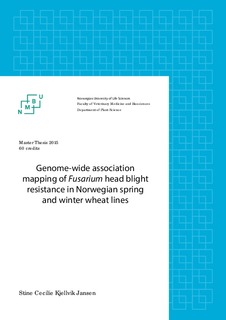| dc.description.abstract | Fusarium graminearum is a species of fungal pathogens known to cause Fusarium head blight impacting grain quality and yield of Norwegian wheat. The genetic background of this disease have been studied over the past two decades. Genome-wide association studies (GWAS), also called association mapping, have proven to be powerful tools in identifying the genetic composition of complex traits. In this thesis, markers from the 90K SNP array with phenotypic data for a core collection of 172 MASBASIS spring and winter wheat lines from 2014 and previous years were analysed with the mixed linear model in Tassel correcting for kinship and population structure. STRUCTURE identified 8 subpopulations in MASBASIS differentiated by geographic origin and spring and winter growth habits. A total of 22 031 markers for spring wheat, and 16091 for winter wheat were used to identify significant markers for earliness, plant height, anther extrusion, Fusarium head blight and mycotoxin deoxynivalenol. All traits were discovered to hold significant markers around previously discovered QTL, indicating that genes controlling these traits may be located at positions around the markers of significance. Heritabilities calculated from analyses of variance demonstrated that the percentages of the observed variances resulting from genetics was much lower for FHB than for DON, suggesting a great impact of environmental effects and experimental error, such as weather and scoring, on the rate of disease. The usefulness of using FHB as a trait in genome-wide association mapping, compared to DON, must therefore be individually determined. DON is considered the most important trait due to the yield and quality loss from mycotoxin infected grain, and gave both high heritability and significant markers from the association mapping from this study. From the field trial of 2014, Norwegian breeding lines had relatively low values for DON compared to the susceptible lines, indicating that breeding for Fusarium resistance have been successful. However, compared to the highly resistant source Sumai 3, there is still a long way to go. Further analyses of resistance is recommended to identify the genes underlying traits for resistance and the specific lines carrying these for use in breeding programmes. | nb_NO |
